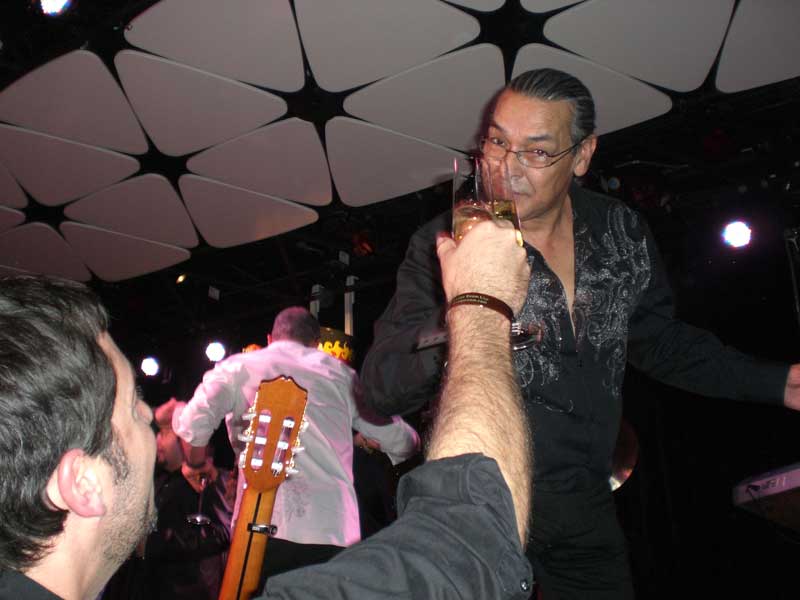Why We Rumba!
Rumba flamenco, also known as flamenco rumba or rumbita, is a popular musical style that emerged in Spain, particularly in the region of Andalusia. It combines elements of traditional flamenco music with Latin American and Afro-Cuban rhythms, creating a vibrant and infectious sound. There are several reasons why rumba flamenco has gained popularity:
- Catchy Rhythms: Rumba flamenco features lively and upbeat rhythms, often characterized by the use of percussion instruments like the cajón (box drum) and palmas (hand clapping). These rhythms are highly infectious and tend to evoke a sense of joy and energy, making it appealing to a wide audience.
- Danceable Nature: Flamenco rumba’s rhythmic structure lends itself well to dance. Its lively tempo and syncopated beats create a vibrant atmosphere that encourages people to move and groove. The dance associated with rumba flamenco is often characterized by fast footwork, expressive hand movements, and a strong connection with the music.
- Blend of Cultural Influences: Rumba flamenco draws from various cultural influences, including traditional Spanish flamenco, Latin American music, and Afro-Cuban rhythms. This fusion of styles makes it a unique and captivating genre that appeals to fans of different backgrounds and musical preferences.
- Popularization by Artists: Rumba flamenco gained significant exposure and popularity through the work of influential artists who incorporated it into their repertoire. One of the most notable examples is the Gipsy Kings, a group of French musicians of Spanish-Romani heritage, who achieved international success with their rumba flamenco-inspired music in the 1980s. Their catchy melodies and energetic performances helped introduce the genre to a global audience.
- Festive and Celebratory Atmosphere: Rumba flamenco is often associated with a festive and celebratory atmosphere. Its joyful and rhythmic nature makes it well-suited for social gatherings, parties, and events where people can come together to dance, sing, and enjoy the lively music.
These factors, among others, have contributed to the popularity of rumba flamenco, both within Spain and internationally. Its infectious rhythms, danceability, cultural fusion, and ability to evoke a sense of joy have made it a beloved genre that continues to captivate audiences around the world.
Here’s a listening list of notable rumba flamenco artists that you can explore:
- Gipsy Kings: One of the most renowned groups in rumba flamenco, known for their infectious melodies and energetic performances. Popular songs include “Bamboleo,” “Volare,” and “Djobi Djoba.”
- Paco de Lucía: A legendary flamenco guitarist who incorporated rumba flamenco elements into his music. Check out his album “Siroco,” which features tracks like “Callejón del Muro” and “La Cañada.”
- Tomatito: A highly acclaimed flamenco guitarist who has also explored rumba flamenco. Listen to his album “Rosas del Amor” for a fusion of traditional flamenco and rumba rhythms.
- Diego El Cigala: A Spanish singer known for his captivating voice and versatility. His album “Picasso en Mis Ojos” showcases his interpretation of rumba flamenco along with other flamenco styles.
- Ketama: A Spanish group that blended flamenco, rumba, and Latin influences. Their album “De Akí a Ketama” features rumba flamenco tracks like “No Estamos Lokos” and “Vente Pa Madrid.”
- Chambao: While primarily known for their fusion of flamenco and electronic music, Chambao has incorporated rumba flamenco elements in some of their songs. Check out tracks like “Pokito a Poko” and “Lo Mejor Pa Ti.”
- Estopa: A duo from Spain that mixes rumba flamenco with rock and pop elements. Their debut album “Estopa” includes hits like “La Raja de Tu Falda” and “Cuando Amanece.”
- Los Delinquentes: Known for their modern take on rumba flamenco, Los Delinquentes infuse their music with humor and streetwise lyrics. Check out their albums “El Sentimiento Garrapatero Que Nos Traen las Flores” and “Los Hombres de las Praderas y Sus Bordones Calientes.”
- La Barbería del Sur: A group that combines flamenco, rumba, and Latin American rhythms. Their album “Historias de la Barbería” features rumba flamenco tracks like “La Hora de La Verdad” and “Para No Verte Más.”
- Pata Negra: A sibling duo that explored the fusion of flamenco, blues, and rumba. Their album “Blues de la Frontera” showcases their unique sound.
These artists represent a mix of traditional and contemporary approaches to rumba flamenco, providing a diverse range of styles within the genre. Enjoy exploring their music!
To listen to Vincent Zorn’s Music, click here : https://vincentzorn.com/
See Vincent live : https://events.scenethink.com/@vincent-zorn
Listen on Spotify : https://open.spotify.com/artist/1OxoHF24rZqyrJYVWd3hfR
Buy music : https://vincentzorn.bandcamp.com/
